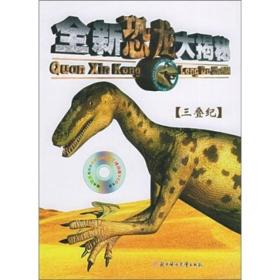
【现货速发】白垩纪松辽盆地松科1井大陆科学钻探工程(SK-1)王成善 等科学出版社
全新正版书籍,可开发票。
¥ 587.3 7.4折 ¥ 798 全新
库存4件
作者王成善 等
出版社科学出版社
ISBN9787030530479
出版时间2017-06
装帧精装
开本16开
定价798元
货号25110508
上书时间2024-11-16
- 最新上架
商品详情
- 品相描述:全新
- 商品描述
-
前言
`
导语摘要
无
商品简介
本书主要介绍了松科1井大陆科学钻探工程的相关工程技术和初步研究成果方面的内容。首先介绍了松辽盆地地质背景和松科1井井位论证的相关内容;其后运用大量钻探过程中的*手资料,介绍松科1井钻探实施和岩心保存的工程技术内容;*后,对松科1井所产出的初步研究成果进行展示。
作者简介
`
目录
Contents
Foreword 1
Foreword 2
Preface
Participant
1. Chief Scientists
2. Advisory Group
3. Scientific Team
4. Technical Team
Section 1 Geological Background of the Songliao Basin 1
1.1 Geologic and Tectonic Evolution of the Songliao Basin 5
1.2 Tectono-stratigraphic Framework of the Songliao Basin 6
1.2.1 Pre-rift and Syn-rift Tectonostratigraphic Units 6
1.2.2 Stratigraphic Sequences of the Early Thermal Subsidence Stage 7
1.2.3 Stratigraphic Sequences of the Late Thermal Subsidence Stage 9
1.3 Palaeoenviromental and Palaeoclimatic Studies of the Songliao Basin 12
1.4 Scientific Objectives of the Continental Scientific Drilling Project of the Cretaceous Songliao Basin 16
1.4.1 Stratigraphic Boundaries and Marineterrestrial Correlation of Stratigraphy 17
1.4.2 Biotic Response to Terrestrial Environmental Change and the DeepBiosphere (Fossil DNA) 18
1.4.3 Terrestrial Response to Oceanic Anoxic Events and Formation of Massive Terrestrial Hydrocarbon Source Rocks 19
1.4.4 Cretaceous Normal Superchron from Terrestrial Records 20
Section 2 Selection of Drilling Site 23
2.1 Process of site selection 24
2.2 Site Location 26
2.3 Simulated Lithological Column for Well SK-1 before Drilling 28
Section 3 Implementation of SK-1 Drilling and Preservation of Cores 33
3.1 Drilling Design 34
3.1.1 Technical Goals 34
3.1.2 Drilling and Coring Requirements 34
3.1.3 “One Well-two Holes” Design Solution 35
3.1.4 Borehole Structure and Casing Procedure 36
3.1.5 Drilling Devices 38
3.2 Intergrated Coring Technique for the Extremely hong and High-recovery Drilling 40
3.2.1 Coring Tools 40
3.2.2 Coring Techniques 41
3.2.3 Directional Coring Technique 43
3.2.4 Fluorescent carboxylation Microsphere Tracing and Sealed CoringTechnique 47
3.2.5 Hydraulic Core Extraction 49
3.2.6 Log Core Identification Techniques and Core Description 50
3.3 Construction Organization and Management of SK-1 51
3.4 Implementation and Technique of Well Logging 52
3.4.1 Logging Design of SK-1 53
3.4.2 Implementation of the SK-1 Well Logging Project 59
3.4.3 Result of the SK-1 Well Logging Project 59
3.5 Comparison and Evaluation of the Designed and Implemented one Well-two Holes Quantities 59
3.5.1 SK-1 North Borehole (SK-1n) 59
3.5.2 SK-1 South Borehole (SK-1s) 61
3.5.3 Quality Evaluation of the SK-1n and SK-1s Engineering 62
3.5.4 Core Depth Location of SK-1 65
3.6 Core Handling and Storage 71
3.6.1 Core Handling and Storage at the Drilling Site 72
3.6.2 Core Scanning and Storage 72
3.6.3 Cutting, Casting and Long-term Preservation of SK-1 Cores 72
3.6.4 Core Sampling of SK-1 75
Section 4 Preliminary Scientific Results of SK-1 79
4.1 Lithostratigraphy 80
4.1.1 Methods and Summary of Core Description 80
4.1.2 SK-1 Core Lithology 80
4.1.3 SK-1 Special Deposits and Their Geological Significance 85
4.2 Paleomagnetism 86
4.2.1 Aims and Significance 86
4.2.2 Sampling and Magnetic DataAnalysis 86
4.2.3 Preliminary Results 87
4.3 Logging Results 90
4.3.1 Aims and Significance 90
4.3.2 Sampling and Analysis 91
4.3.3 Preliminary Results 91
4.4 Inorganic Geochemistry and Mineralogy 92
4.4.1 Research Objectives and Significance 92
4.4.2 Sampling and Analytical Methods 92
4.4.3 Preliminary Results 93
4.5 Chronostratigraphy 101
4.5.1 Aims and Significance 101
4.5.2 Sampling and Analytical Methods 101
4.5.3 Preliminary Results 102
4.6 Geomicrobiology 107
4.6.1 Research Objectives and Significance 107
4.6.2 Materials and Methods 107
4.6.3 Preliminary Data 108
4.7 Organic Geochemistry 112
4.7.1 Objectives and Significances of Organic Geochemistry Research 112
4.7.2 Sampling and Experimental Methods of Organic Matter Analysis 113
4.7.3 Preliminary Results 114
4.8 Stable Isotopes 117
4.8.1 Aims and Significance of This Study 117
4.8.2 Methods and Sampling 118
4.8.3 Preliminary Results 119
4.9 Cyclostratigraphy 120
4.9.1 Cyclostratigraphy of Sedimentary Strata in SK-1 121
4.9.2 Floating Astronomical Time Scale for Qingshankou Formation, SK-1s 122
4.10 Biostratigraphy 126
4.10.1 Aims and Significance 126
4.10.2 Materials and Methods 126
4.10.3 Preliminary Results 126
Section 5 SK-1 Core Description and Core Photographs 133
5.1 Stratigraphic Chart 134
5.1.1 Quantou Formation Members 3 and 4 134
5.1.2 Qingshankou Formation Member 1 149
5.1.3 Qingshankou Formation Members 2 and 3 155
5.1.4 Yaojia Formation 189
5.1.5 Nenjiang Formation Members 1 and 2 203
5.1.6 Nenjiang Formation Members 3, 4 and 5 227
5.1.7 Sifangtai Formation 281
5.1.8 Mingshui Formation 307
5.1.9 Taikang Formation 363
Reference 656
Appendix 667
Acknowledgements 691
内容摘要
无
主编推荐
`
精彩内容
Section 1 Geological Background of the Songliao Basin
The Songliao Basin in northeastern China is 750 km long, 330—370 km wide and has a total area of 26×104 km2. The basin is divided into six structural units: the northern plunge, central downwarp, northeastern uplift, southeastern uplift, southwestern uplift, and western slope (Figure 1.1). The mainoil and gasproducing province is in the central downwarp, which includes the Daqing anticline, Qijia-Gulong, Sanzhao and Changling sags and Chaoyanggou terrace.
Figure 1.1 Location map of the Songliao Basin showing major structural divisions. Lines of cross section and seismic sections show locations of Figure 1.2 (A-A′) and Figure 1.8 (B-B′). Ⅰ. western slope; Ⅱ. Northern plunge; Ⅱ1. Nenjiang terrace; Ⅱ2.Yian sag; Ⅱ3. Sanxing anticline; Ⅱ4. Keshan-Yilong anticlinal belt; Ⅱ5.Qianyuan anticlinal belt; Ⅱ6.Wuyuer sag; Ⅲ1. central downwarp; Ⅲ1, Heiyupao sag; Ⅲ2. Mingshui terrace; Ⅲ3. Longhupao-Da’an terrace; Ⅲ4. Qijia-Gulong sag; Ⅲ5. Daqing Changyuan anticline; Ⅲ6. Sanzhao sag; Ⅲ7. Chaoyanggou terrace; Ⅲ8. Changling sag; Ⅲ9. Fuyu uplift; Ⅲ10. Shuangtuozi terrace; Ⅳ. northeastern uplift; Ⅳ1. Hailun uplift; Ⅳ2. Suiling anticline; Ⅳ3. Suihua sag; Ⅳ4. Qing’an uplift; Ⅳ5. Hulan uplift; Ⅴ. Southeastern uplift; Ⅴ1. Changchunling anticlinal belt; Ⅴ2. Binxian-Wangfu sag; Ⅴ3. Qingshankou uplift; Ⅴ4. Denglouku anticlinal belt; Ⅴ5. Diaoyutai uplift; Ⅴ6. Yangdachengzi anticlinal belt; Ⅴ7.Yushu-Dehuisag; Ⅴ8. Jiutai terrace;Ⅴ9. Dehui-Lishu sag; Ⅵ. southwestern uplift zone; Ⅵ1. Gamatu uplift; Ⅵ2. Kailu sag.
The basin contains Jurassic, Cretaceous, Palaeogene and Neogene clastic deposits that are about 10 km thick in the basin centre. Sediment fill thins toward the basin margins resulting in a cross-sectional steer’shead geometry (Figure 1.2). These sediments are underlain by Palaeozoic metamorphic, plutonic and volcanic rocks (Tian and Han, 1993; Gao and Cai, 1997). The basin was formed and filled in four tectonic stages:mantle upwelling, rifting, postrift thermal subsidence and structural inversion. The first stage occurred during the Middle and Late Jurassic, and is characterized by doming, extension and widespread volcanism. Upper Jurassic to Lower Cretaceous pre-rift and syn-rift deposits (pre-rift and syn-rift tectonostratigraphic units) occur only within isolated fault blocks with a maximum thickness of 7000 m in the Shiwu and Dehui sags (Xie et al., 2003). Lower to Upper Cretaceous post-rift deposits (post-rift tectonostratigraphic unit), with a thickness of 3000—4000 m (maximum 6000 m), unconformably overlie syn-rift strata and extend beyond the fault blocks to cover the whole basin. Palaeocene and Eocene deposits (structural inversion tectonostratigraphic unit) with a thickness of 0—510 m, occur only locally in the western part of the basin. A generalized stratigraphic column of the Songliao Basin is shown in Figure 1.3.
Figure 1.2 Regional seismic section and structural cross section across the central part of the Songliao Basin. Lithologic and formation information derived from geophysical logs and cores are tied to seismic sections. Location of the section is shown in Figure 1.1 (A-A′).
Figure 1.3 Generalized stratigraphic column of the Songliao Basin.
Large-scale geological investigation of Songliao Basin for petroleum started in 1956, and on September 26, 1959, the first highly productive oil well (known as the Songji-3 Gusher) was successfully drilled, initiating the beginning of the Daqing Oilfield. Since then, extensive exploration work has been conducted in the Songliao Basin. By the end of 2000, over 250,000 km of seismic reflection profiles had been completed. The area of the seismic network is 0.5 km×0.5 km to 2 km×4 km, and some 3D seismic reflection data have also been acquired. About 50,000 wells have been drilled, with a cumulative drill penetration of about 40 million meters. In recent years, more wells have been drilled to the level of the Lower Cretaceous, that provides Section 1 Geological Background of the Songliao Basin 5 reference points for the proposed deeper drilling program, and which form the basis for detailed stratigraphic correlation and derivative reconstructions of Cretaceous paleoenvironments, and permit identification of an optimum drilling location.
1.1 Geologic and Tectonic Evolution of the Songliao Basin
The evolution of the Songliao Basin can be separated into four stages: pre-rift doming, extensional faulting, downwarping (driven by thermal subsidence) and structural inversion.
Pre-rift doming stage: at the end of the Paleozoic, at the northern edge of the North China Plate, the paleo-Asian sea closed along the Chifeng-Kaiyuan to Xi Lamulun River faul
相关推荐
-

【现货速发】中国少年科幻之旅——白垩纪往事
九品杭州
¥ 2.50
-

(正版速发)全新恐龙大揭秘*白垩纪2
全新北京
¥ 4.93
-

恐龙星球:白垩纪1.三叠纪(3.D)(现货速发)
九品北京
¥ 20.00
-

王宝松 (现货速发)
九品广州
¥ 48.00
-

【现货直发】白垩纪/恐龙时代 清英 著明天出版社
八五品苏州
¥ 4.80
-

现货速发 迷失在白垩纪(4) 9787533959647 林中之马的魔王 浙江文艺出版社
全新北京
¥ 26.50
-

现货速发 迷失在白垩纪(10) 9787533959708 林中之马的魔王 浙江文艺出版社
全新北京
¥ 32.30
-

现货速发 迷失在白垩纪(3) 9787533959630 林中之马的魔王 浙江文艺出版社
全新北京
¥ 32.30
-

现货速发 迷失在白垩纪(8) 9787533959685 林中之马的魔王 浙江文艺出版社
全新北京
¥ 26.50
-

(正版速发)白垩纪公园 9787555703228 货号:L033-25-02
九品杭州
¥ 0.90
— 没有更多了 —













以下为对购买帮助不大的评价